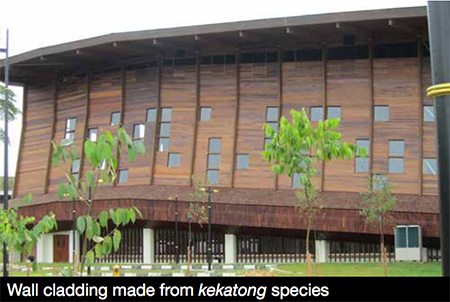Glued laminated timber (glulam) is manufactured by bonding together individual laminations of solid timber. This produces members of a rectangular cross section that are larger and longer than may be obtained simply by sawing a normal log. Glulam is readily available, reliable and has an adaptable design. Prefabricated structural components are regularly manufactured from glulam since it is one of the most versatile construction materials.
Advantages of glulam
Design flexibility
Glulam can be manufactured to a wide range of dimensions and custom built to a straight, cambered or curved shape and any size. Strong and fire-resistant Glulam has superior strength properties and high strength-to-weight ratio, and does not burn easily. Fire in a glulam beam goes out by itself unless it is directly exposed to flames. The carbonised layer protects the beam against further destruction by fire. Glulam from hardwood timber has a smaller dimension compared with softwood timber for the same design load, as well as good fire resistance or better charring rate compared with glulam made from softwood timber such as pine and spruce.
Visually attractive
Glulam provides opportunities to create aesthetically demanding and attractive structures.
Easy to machine and assemble
Glulam members can be easily handled and on-site machining can be done with normal hand tools. Glulam can be prefabricated, including with connectors, for speedy installation.
Ecologically sustainable
Timber is the only 100-percent renewable raw material. It stores carbon rather than emits it. Manufacturing wood products consume lesser energy than other building materials. Timber provides natural warmth and beauty.
Compliance with standards
Glulam is manufactured by complying with several Malaysian standards, including:
• MS 758: 2001 Glued Laminated Timber – Performance Requirements and Minimum Production Requirements (First Revision)
• MS 544: Part 3; 2001 Code of Practice for Structural Use of Timber: Permissible Stress Design of Glued Laminated Timber
• MS 1714: Visual Strength Grading for Sawn Hardwood Timber
• MS 1553/BS 6399-2/BS EN 1991 – Wind Loading and Other Loadings
Galeri Glulam in Johor Bahru (GGJB)
The long-term investment in glulam is to ensure sustainability of the timber industry in Malaysia in various aspects that cover innovation and timber engineering as well as R&D. The construction of GGJB was one of the efforts carried out by the Malaysian Timber Industry Board (MTIB), an agency under the Ministry of Plantation Industries and Commodities (MPIC) Malaysia, which is responsible for encouraging the use and commercialisation of glulam as one of the engineered timber products to be used as load-bearing structures in the construction industry. This effort was also in line with the aspiration of the National Timber industry Policy (NATIP) to enhance greater use of Malaysian timber in the domestic market. The GGJB building presents a creative and distinctive design that used 39 sets of glulam load-bearing structures made from resak and keruing timbers. The glulam members were manufactured by a pioneer glulam manufacturer in Malaysia, Woodsfield Glulam Industries Sdn Bhd, which is located in Pasir Gudang, Johor.
The building showcased glulam as new engineered timber product (ETP) structures in Malaysia made from Malaysian tropical timbers. The building utilised more than 640 cubic metres of timber for its structure and secured more than an 80-percent score under the Industrialised Building System (IBS), which was in line with the government regulation that set at least a 70-percent IBS score for physical development projects in Malaysia. IBS is one of the initiatives by the Malaysia government to reduce the reliance on foreign labour as well as to reduce waste of materials in construction. Other notable examples Malaysia Pavilion at Expo Milano 2015 This article was contributed by the Malaysian Timber Industry Board (MTIB).  The construction of GGJB has broadened architectural horizons in the design and application of glulam from Malaysian hardwood. Hardwood glulam is continuously promoted by MTIB to the domestic as well as international markets with strong support from the stakeholders, including the Public Works Department (PWD), higher learning institutions such as UiTM, as well as other government agencies such as MATRADE/MITI and Ministry of Agriculture.
The construction of GGJB has broadened architectural horizons in the design and application of glulam from Malaysian hardwood. Hardwood glulam is continuously promoted by MTIB to the domestic as well as international markets with strong support from the stakeholders, including the Public Works Department (PWD), higher learning institutions such as UiTM, as well as other government agencies such as MATRADE/MITI and Ministry of Agriculture.
Crops For the Future Research Centre (CFFRC) The application of glulam could be found in a prominent project, i.e., the three domes for Crops For the Future Research Centre (CFFRC) in Semenyih, Selangor awarded to Woodsfield Group of Companies. CFFRC is used as a research centre by the University of Nottingham, Malaysia to provide research support for the global Crops For the Future organisation.
 The Malaysia Pavilion at Expo Milano 2015 in Milan, Italy was another project awarded to the same group, whereby glulam seeds were utilised. It was designed by well-known architect Hijjas Kasturi, whose design was inspired by rainforest seeds. The architectural design incorporated Green features in line with the sustainability theme of the Expo. The external structures of the seeds were constructed with glulam. The choice of using this material, combined with the structurally complex form of the pavilion, was a deliberate effort to showcase Malaysia’s capabilities in both design and creative materials.
The Malaysia Pavilion at Expo Milano 2015 in Milan, Italy was another project awarded to the same group, whereby glulam seeds were utilised. It was designed by well-known architect Hijjas Kasturi, whose design was inspired by rainforest seeds. The architectural design incorporated Green features in line with the sustainability theme of the Expo. The external structures of the seeds were constructed with glulam. The choice of using this material, combined with the structurally complex form of the pavilion, was a deliberate effort to showcase Malaysia’s capabilities in both design and creative materials.

 Hong Kong
Hong Kong Singapore
Singapore Indonesia
Indonesia Tiếng Việt
Tiếng Việt ประเทศไทย
ประเทศไทย








